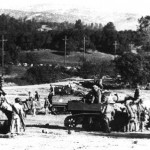Asian-American History, Ask A Librarian, California History
Finding Fact in Fiction
I heard we had a Japanese Internment Camp in Napa. Is that true?
Over the years many patrons have come to Napa County Historical Society asking about a rumored Japanese Internment Camp in Napa during World War II. Some of younger volunteers had no idea there may have been such a camp in Napa, while many older volunteers said they were told of its existence in history classes at the local high schools. Puzzled by this contrast, we began to scour the obvious resources available in the Society’s Research Library to ascertain if there was any historical evidence of internment camps in Napa County. Our search took us to our online database, archives, and manuscripts, but nothing could be found.

We headed to the Napa County Library where we discovered that there was a WWII Prisoner of War Camp in Napa. The POW camp was a branch camp of the base camp Beale, based in Yuba County. The Napa POW camp held about 250 German prisoners beginning August 14, 1945, after the war in the European Theatre ended and a day before the Japanese surrendered (the war ended entirely on September 2, 1945). The POW camp was located on Silverado Trail north of Yountville.
So-called “branch camps” of larger military installations were common during the war. Branch camps in Northern California included Angel Island (a POW processing center), Davis, and King County. These camps typically held 250-500 POWs and the prisoners performed mostly agricultural duties in the surrounding communities. Toward the end of the war, the government often used existing agricultural and farm labor camps to house POWs for a short period of time. California was likely seen as the prime location for these short-term POW camps due to the temperate climate and year-round agricultural work.
While this information was interesting, it didn’t quite answer our original question about a Japanese Internment Camp in Napa. Back to the books. We decided to throw our nets a little wider this time, and learned about “enemy aliens” being banned from “restricted areas.” On February 19, 1942, a few months after Pearl Harbor and the United States finally entering the war, President Franklin D. Roosevelt authorized the government to declare parts of the county as “military areas” from which certain groups of people could be excluded. It also allowed for the internment of “foreign enemy ancestry,” which included not only people of Japanese descent, but also Koreans, Germans, Italians, and even some Jewish refugees who fled Germany. One of the restricted areas was the Northern California coast.
After extensive research, we were unable to validate the stories of a Japanese Internment Camp in Napa. Though this may seem disappointing, it revealed to us that there may be many different stories floating around Napa with no basis in verifiable facts. Maybe some Japanese Americans passed through the Napa Valley en route to internment camps or inland areas beyond the restricted zone. Or perhaps some people erroneously assumed the POWs in the Napa Camp included Japanese soldiers. It is likely that, like a game of Telephone, what started out as gossip about the German POW camp eventually morphed into a legend of a Japanese Internment Camp. It is our job at the Historical Society not to pass judgment, but to uncover the truth.
Written by Lauren Chevlan and Kristen Baslee, with assistance from Alexandria Brown. A version of this article also appeared in the Napa Register, July 7, 2013.

